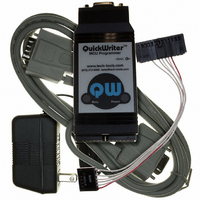QW1 TechTools, QW1 Datasheet
Specifications of QW1
Available stocks
Related parts for QW1
QW1 Summary of contents
Page 1
In-Circuit Programming with QuickWriter™ This is an application note describing how to design your target for proper in-circuit programming with a QuickWriter. THE’IDEALS’ The IDEAL programming environment varies widely, depending on whose perspective you take. Programming hardware’s Ideal From the ...
Page 2
IMPLEMENTATION QuickWriter is designed to make In-Circuit programming as hassle free as possible. It allows the hardware and firmware developers to come as close to their ideals as possible and still do reliable in-circuit programming. QuickWriter includes several features to ...
Page 3
DESIGNING FOR IN-CIRCUIT PROGRAMMING In addition to the in-circuit support built into QuickWriter, there are still a few basic requirements on the target to make it in-circuit programmable. The following defines the key issues related to each signal involved in ...
Page 4
VCC (2) Who powers the target possible to do in-circuit programming with the programmer powering the target or with the target powering itself. There are trade-offs and limitations with each choice. Programmer Powered The programmer can provide up ...
Page 5
Self Powered This is often the best choice. It eliminates any concern over back-feeding power supplies or about multi-voltage targets being partially powered. It most closely mimics the target’s intended operational modes. However, there is one situation in which programmer ...
Page 6
... Always connect the ground pin - Decide who powers the target and address the trade-offs involved. - Enable the PICmicro MCU’s power-up timer if possible. Particularly if using a device with internal MCLR. QuickWriter is a trademark of TechTools. PIC and PICmicro are trademarks of Microchip Technology Inc. ...


















